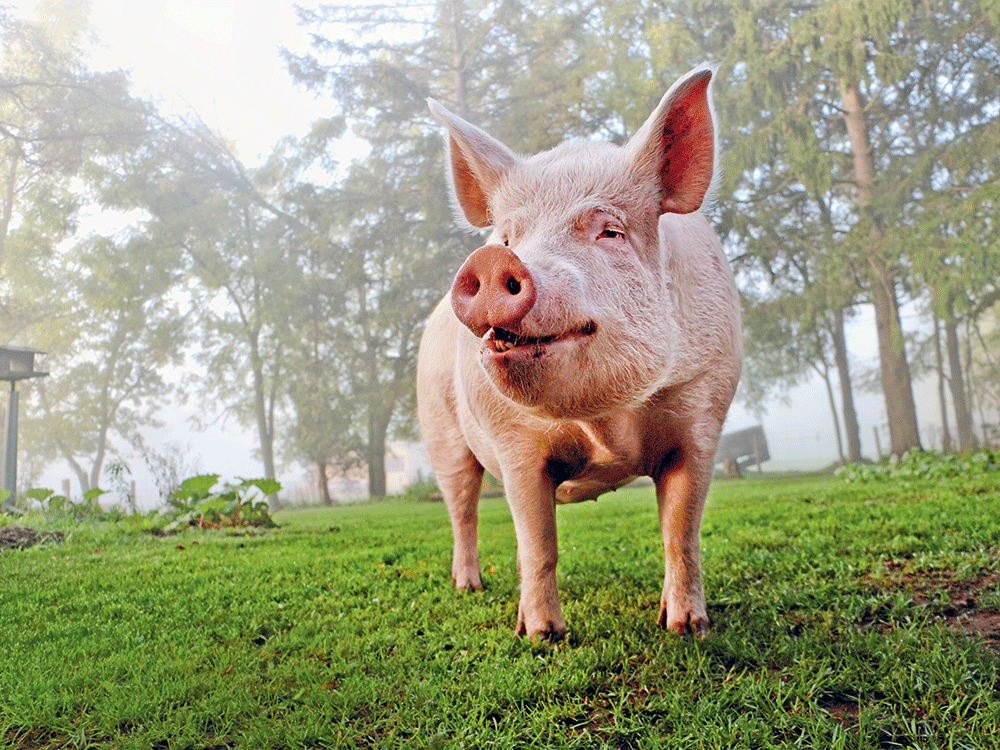
How Esther the Wonder Pig Changed This Family’s Life Forever
There’s little point to a life that lacks excitement. But there’s excitement, and then there’s a freight train hurtling towards your bedroom at 3 a.m. on a regular basis.
We call it the Piggy Parade.
There’s nothing peaceful about being awoken by a 295‐kilogram pig barrelling down a hallway. It’s something you feel first: a vibration that rumbles through the mattress into your consciousness. You have just moments to realize what’s happening and to react. Over the din of humans (me and my partner, Derek) and animals (dogs Reuben and Shelby, and cats Delores and Finnegan) rushing to move out of the way comes the sound of hooves racing across the hardwood floor, getting louder by the second.
Within moments, our darling pig, Esther, comes crashing in from the living room where she sleeps, most likely spooked by a noise. She launches into our bed much the same way she launched into our lives. While it might be a mad scramble to make space for her, it’s more than worth it.
Before meeting Esther in 2012, we were already two guys, one girl, two dogs and two cats living in a modest single-level house in Georgetown, Ont., a small community just over 50 kilometres west of Toronto. Derek and I shared one bedroom, we had a roommate occupying another, and the remaining one was an office from which I ran my real estate business and Derek made phone calls to book his magic shows.
It was cramped, so we tried our best to give one another space. I’d frequently take my laptop to the living room and work from there when Derek was in the office. We were in this configuration when I received a Facebook message from a woman I knew from middle school, someone I hadn’t spoken to in 15 years.
“Hey Steve. I know you’ve always been a huge animal lover. I have a mini pig that’s not getting along with my dogs. I’ve just had a baby, and I can’t keep the pig.”
It’s true that I’ve always loved animals: my very first best friend was my childhood dog, Brandy, a shepherd mix, brown and black, with floppy ears and a long straight tail. So I was intrigued. A mini pig sounded adorable. In hindsight, of course, the whole situation was bizarre, but I’m a very trusting person.
I replied casually, “Let me do some research, and I’ll get back to you,” but I knew I wanted the pig. I just had to figure out how to make it happen.
It’s tricky enough to bring a pig back to the house you share with several other pets, a roommate and your long-time partner. But on top of that, only nine months earlier, I’d brought Delores home without talking to Derek about it. As you might expect, he didn’t react well.
I had to plan this right, to make it look like I wasn’t doing something behind Derek’s back—even though I was doing something behind his back.
A few hours later, I got another message from the woman:
“Someone else is interested, so if you want her, great. If not, this other person will take her.”
Plus: 12 Extraordinary Real Life Stories About the Kindness of Strangers
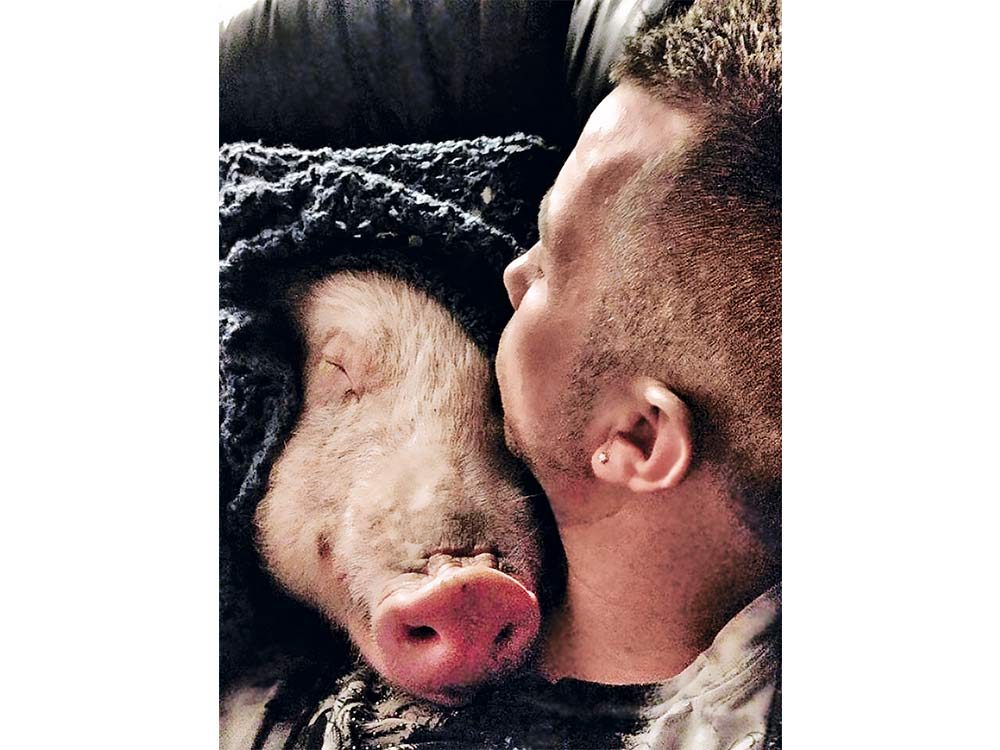
You’re probably smart enough to recognize this as a manipulative tactic, and normally I’m smart enough, too. But I was not letting that pig go. So without thinking it through, I told my former classmate that I’d take the animal. I gave her my office address, and we agreed to meet there in the morning.
I knew nothing about mini pigs. I didn’t know what they ate; I had no idea how big they got. Once I started doing some Internet research, I found a few assertions that there’s no such thing as a mini pig, but I was blinded by my sudden obsession and my faith in my one-time friend.
It seemed this pig would grow to be about 32 kilograms, maximum. That was pretty close to the size of Shelby, our pit bull–terrier mix. That seemed reasonable.
She was tiny—maybe 20 centimetres from tip to tail. The poor thing had chipped pink nail polish on her little hooves and a tattered sequined cat collar around her neck. She looked pathetic yet lovable.
My former classmate said the pig was six months old and spayed and that she’d had her for a week, having gotten her from a breeder through Kijiji. I watched the woman handle the pig, and I could tell there was zero attachment.
I’d met the pig 12 minutes ago, and I already knew she needed me. I had only a few hours to figure out what to tell Derek. (Do you have cute animals as part of your family? These readers certainly do!)
In the car on the way home, the pig sat in the front passenger seat, skittish and disoriented. I talked to her and petted her while we took back roads to our house and I planned my emergency “please forgive me for getting a pig” dinner for Derek (his favourite: fresh burgers with cheese and bacon, and homemade garlic fries).
The cats were their typical curious‐but‐uninterested selves when faced with the pig. The dogs are excitable around baby animals and children, so they whined and jumped. I held onto the pig securely and let them sniff her a little before I hid her in the office. I figured I’d better make sure Derek was in a good mood before springing the new arrival on him.
Derek stood in the doorway like a statue. Every emotion other than happiness flashed across his face. It didn’t take more than a half‐second for him to realize what I’d done and what I now wished to do.
He was furious. He went on about how irresponsible I was; he insisted there was no more room in the house. The only positive thing I could say was, “She’s a mini pig! She’ll stay small!”
I knew that what I’d done was wrong, but I really hoped I could smooth things over. I loved Derek and I loved our life together, and I truly believed he’d come around.
We’ve rounded up 10 of the best (and cutest) YouTube cat videos you’ll ever see.
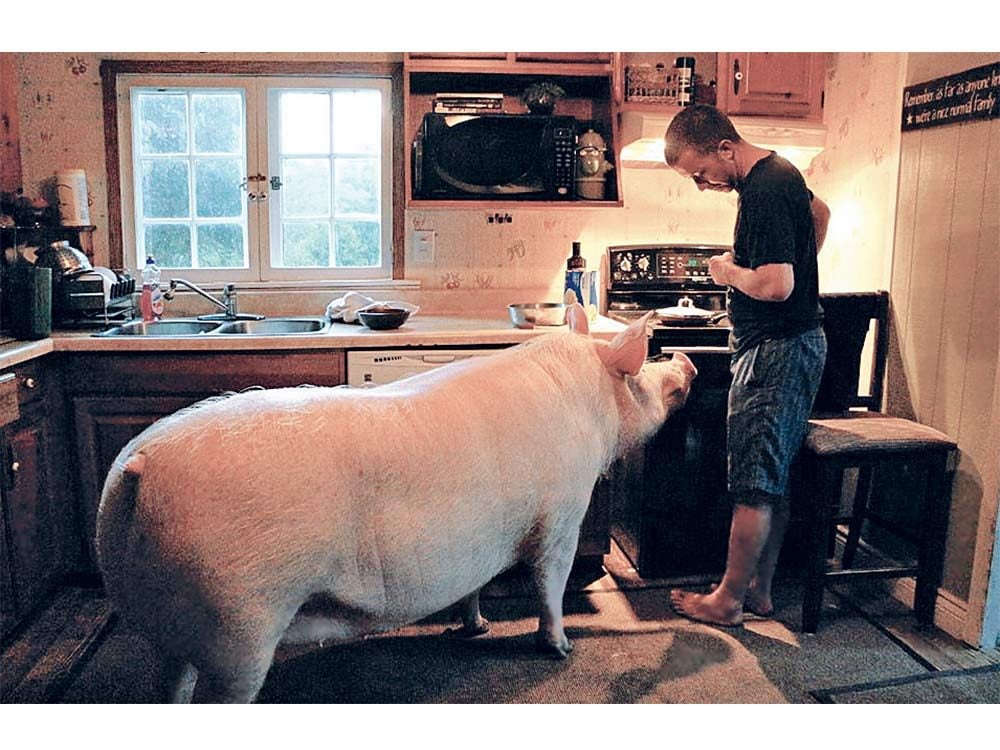
Back when I sprung Delores on Derek, he refused to give the cat a “real” name at first. In the same way, he started off referring to the pig as Kijiji. He wasn’t going to give a name to an animal we weren’t keeping. But two weeks in, he stopped calling her Kijiji, and we christened her: we wanted to evoke a wise old soul, and “Esther” felt right.
One night, we were having dinner and Derek started talking about where Esther’s litter and pen would go. You don’t build a pen for someone you’re getting rid of. That’s when I knew.
As soon as the veterinarian saw Esther, he shot me a bemused look.
“What do you know about this pig?” he asked. I gave him the story, or at least the one I’d been told.
“Well, I already see a problem. Look at her tail. It’s been docked,” he said.
“Is that why it’s a little nub?” I asked.
“Exactly,” the vet said. “When you have a commercial pig—a full‐size pig—the owners will generally have the pig’s tail cut back. This minimizes tail biting, which occurs when pigs are kept deprived in factory farm environments. If Esther really is six months old, she could be a runt.”
This threw me.
“You think my friend lied?” I asked. “I know this person.”
“And I don’t. So you could very well have a commercial pig that’s a runt. If that’s the case, when fully grown, she could be about 110 kilograms.”
“Okay,” I said.
“But if not, well, I guess we’ll cross that bridge when we get to it.”
The vet explained that the only way to know anything for sure would be to weigh and measure Esther and start a chart. Pigs have a very specific rate of growth.
Over the next couple of months, we settled into a routine. We took her for late-night walks with the dogs. Everything was under control.
But at our next vet appointment, six weeks after we’d adopted Esther, I had to admit that she’d been growing quickly. Over that short time, she’d already closed in on 36 kilograms, the size of a small mini pig.
I tried to get access to Esther’s vet records, but my former classmate had gone silent. Even without them, it was becoming clear that I’d probably adopted a commercial pig—and she was going to be enormous.
Want to more heartwarming animals stories? Check out How the Calgary Zoo Saved 200 Animals From the Flood.
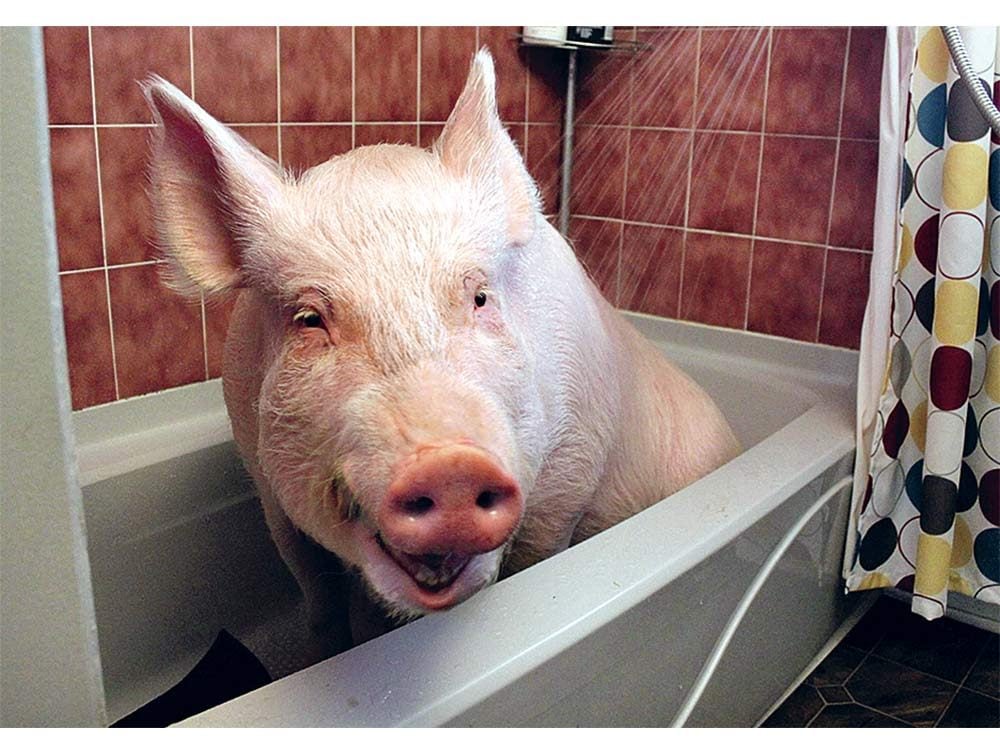
I hadn’t known I’d wanted a pig, but the joy I felt once I knew I would always be going home to her made me smile. Everything about Esther was precious: the way she shuffled around, the way her little hooves slid along the floor when she ran, the funny little clicking noise she made when she pranced. She’d also nuzzle our hands to soothe herself, licking our palms and rubbing her snout up and down as she fell asleep.
With any pet, the first time it makes a particular sound or moves in a specific way, you’re trying to glean the meaning. You want to understand what this animal—now your family—is thinking and feeling. As soon as you start opening your heart to a creature, you start opening your mind to what it’s trying to tell you. Is that squeal an expression of delight, fear, hunger or surprise? Is that tilt of the head suggesting curiosity, concern or confusion?
One thing I didn’t expect was just how many behaviours Esther would share with the dogs. She’d play with a toy as they would, shaking it back and forth. She’d want to chase the cats, and cuddle when she was tired, climbing into our laps to nuzzle (which she did at 90 kilograms, a weight she reached by the time she was nine months old). And just like the dogs, she often wanted our attention.
We didn’t do anything special to train her or turn her into what she was becoming. All we did was treat her like one of the dogs. She started playing and doing other hilarious and clever things on her own. And that struck us to our cores.
What made pigs different? Why were they bred for food and held in captivity, while dogs and cats were welcomed into our homes and treated like family? Aside from physicality, we could see no difference between her and our dogs. (Okay, Esther hardly had any tail left to wag. But if it had been there, it would have been happily wagging away most of the time.)
Why were pigs the unlucky ones? Why hadn’t we realized they had such engaging personalities and such intelligence? And where would Esther be now if she hadn’t joined us? She had become as integral to our home as the foundation, the walls and the floors beneath our feet.
A few weeks after getting Esther, we realized we had to stop eating bacon. Shortly after that, with some difficulty, we cut out meat entirely. And a few months after that, with greater difficulty, dairy and eggs followed. We were officially vegan—or “Esther Approved,” as we like to call it.
The following year, in December 2013, we started a Facebook page for Esther. It took off immediately, and soon everyone seemed to know all about her (we now have more than 800,000 followers). That’s when it became clear that Esther could help encourage other people to reflect on what they eat and why.
Plus: 3 Funny Pet Stories That Prove We’ll Do Anything for Our Favourite Animals
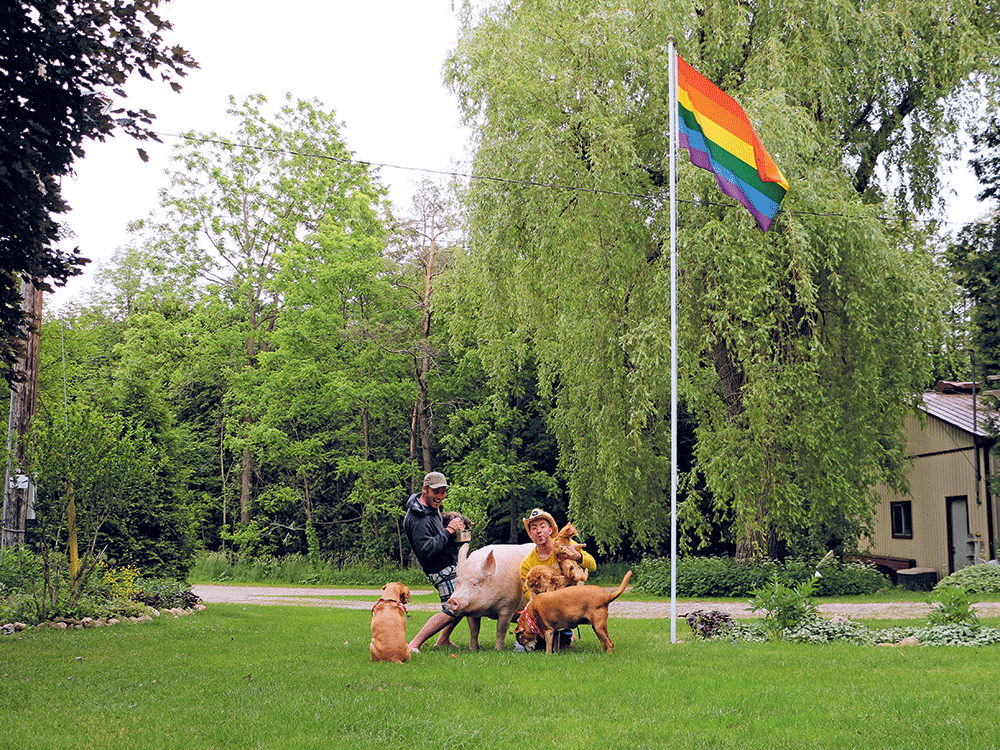
In November 2014, we moved a half-hour drive from Georgetown to Campbellville, Ont. That’s where, with backing from 8,000 of Esther’s fans in 44 countries, we founded the Happily Ever Esther Farm Sanctuary, where we rescue and rehabilitate abandoned and abused farmed animals. Esther has changed our lives—that’s obvious. Now it’s our turn to try to change the world for the rest of the Esthers out there.
It’s become our mission to share what Esther taught us, and to teach everyone that we can all become kinder and more open‐minded.
Derek and I have done so many things we never thought we would. We didn’t think we could live an “Esther Approved” lifestyle, but we did it. We didn’t think we could raise a 295‐kilogram pig, but we did it. And we surely didn’t think we could rally thousands of people from around the world to help us buy and build a farm sanctuary, but we did that too.
Life today is definitely different. For starters, it’s really dark on the farm at night, and I am apparently terrified of the dark.
I also never expected to have piglet afterbirth on my hands on April Fool’s Day in 2015. No, Esther didn’t get knocked up. We rescued a pregnant pig who gave birth to a quintet of little squeakers. Now we have five beautiful piglets who will live out their lives with their mother—whom we named April—by their side.
We have provided a safe home for 33 animals: six rabbits, six goats, two sheep, 10 pigs (not including Esther), one horse, one donkey, three cows, three chickens and a peacock. That’s in addition to our original five pets. And we have requests to take in new additions almost every day. By the time you’re reading this, the number will have grown. We look forward to welcoming even more residents to our farm, where they can all live “Happily Ever Esther.”
Looking for wild content? Check out Hero Pets: The Big Hearted Lion.
From the book Esther the Wonder Pig by Steve Jenkins and Derek Walter, with Caprice Crane. © 2016 by ETWP, Inc. Reprinted by permission of Grand Central Publishing, New York, NY. All rights reserved.